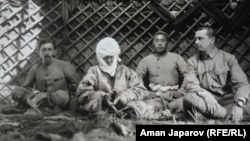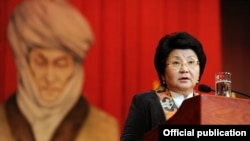When I found out several months ago about the upcoming release of "Kurmanjan Datka, Queen Of The Mountains," it was an exciting thought for me. Like most who have traveled around Kyrgyzstan, I have seen statues to Kurmanjan Datka and streets named after her. But I only got pieces of her story here and there while I was wandering around the country, so I still wonder who exactly was Kurmanjan Datka and how significant is she to the Kyrgyz today?
Emily Canning's fine review of the movie includes a point I always felt keenly when she mentions a Kyrgyz girl who saw the film saying, "Other people wouldn't understand, but I feel this movie in my heart."
Indeed. How could I understand?
So I decided to contact someone who would understand and fortunately (very fortunately) for me I know Tynchtykbek Tchoroev (Chorotegin) who even among the Kyrgyz people is regarded as one of the leading sources of information about the nation and its history.
And because I've known him for so long I'm going to call him "Tynch" throughout this article. After all of these years Tchoroev just doesn't sound right to me. He's Tynch.
Tynch told me there were a few other female datkas ("datka" in Kyrgyz; "dadhoh" in Persian, means "righteous ruler") in the first half of the 19th century, but none who compared to Kurmanjan (1811–1907), the daughter of Mamatbay from the Kyrgyz tribe of Mungush, because only Kurmanjan's authority as a powerful local ruler in the Alai Mountains and surrounding areas was recognized by three nations -- Kokand, Bukhara, and Russia.
She was given in marriage to a man she did not want and she fled back to her family. Such a thing is not heard of even today in the arranged marriages of people in the sedentary parts of Central Asia and in the 19th century it represented a major violation of patriarchal tradition, Tynch explains.
Kurmanjan's decision to marry a man she loved was also not the custom, though in her case the affection was reciprocated by Alymbek Datka (1799-1862), the son of Asan-biy from the tribe of Bargy, a part of the Kyrgyz tribe of Adygene, whom she married in 1832.
Tynch says Kurmanjan's stubbornness and insistence on marrying for love is "the main message of the life of Kurmanjan, a hero of freedom for the Kyrgyz women."
Alymbek was a capable nobleman who supported the unity of the Kyrgyz people and independence of the Kokand Khanate from tsarist Russia. Alymbek Datka was the governor of the Andijon Province in the Kokand Khanate and the "atalyk" (regent) of the 12-year-old Shah Murad, the khan of Kokand (in 1862, just before his own assassination).
After her powerful husband's assassination, Kurmanjan became datka, a transfer of power approved not only by the Kokand khan, who ruled lands that included Osh and Kurmanjan's homeland in the Alai Mountains, but also by Muzaffar, the emir of Bukhara, who temporarily ruled most of the Kokand Khanate during his invasion of this eastern Central Asian state.
Muzaffar officially met with Kurmanjan Datka in the city of Osh, not in the Alai Mountains, as depicted in the film.
Kurmanjan became, as Tynch says, "a kind of general on one hand, and on the other hand a governor." And it was a bad time to be either, for the Kokand Khanate was in decline and the Russian Army was making its way further into Central Asia.
Kurmanjan's husband had fought against the tsar's advancing army and some of her children did also. For instance, Abdylda-Bek, the older son of Alymbek Datka and Kurmanjan Datka, was a leading commander of the army of "Pulat Khan" during the huge people's uprising against the advancing Russian regime. Pulat Khan was a Ferghana Kyrgyz mullah named Iskhak Asan-uulu, who led the last powerful uprising against both pro-Russian Khudayar Khan and the Russian colonial administration.
Pulat Khan was executed by the Russians and Abdylda-Bek fled to Afghanistan via Pamir. He died in Afghanistan in 1877.
But vastly outmatched, "Kurmanjan was wise enough to persuade the other Kyrgyz people not to fight against the very powerful Russian Army," Tynch notes.
As mentioned in Canning's film review, Kurmanjan did not fight to save her son from being executed by the Russians, according to some versions of Kurmanjan's story, she even attended the execution. She would not sacrifice the future of her people to save one of her offspring.
That is another message from Kurmanjan Datka's life, Tynch says, that "her greatness was seen in the work for the interests of her people." As he says, "in the case of Kurmanjan, it's a reminder that a wife, a woman, could lead her nation."
With all due respect to contemporary women in Asian politics such as Indira Ghandi, Benazir Bhutto, and Aung San Suu Kyi, Tynch adds that "Kurmanjan Datka was such a woman at the end of the 19th century."
Tynch notes that while the Russians treated Kurmanjan with respect and even bestowed the title "tsaritsa Alaia" (queen of the Alai) on her, she was still "one of the tools to persuade the other Kyrgyz people in that region to live in peace within the framework of colonial Russia."
But Kurmanjan was tolerant of different cultures, he adds, an important aspect since the area she lived in was and still is inhabited by scores of different peoples.
The people of her day seemed to respect Kurmanjan Datka for this tolerance and her ability to govern, because records of her can be found "preserved in many manuscripts in Chagatai Turkic, Farsi (Persian), Kyrgyz, and other languages in Arabic script."
One of the new legends about Kurmanjan Datka is the myth that she was writing poems in Persian and signing them with the name of Zinat. But Kyrgyz historians reject this, saying that Zinat was a male poet's pseudonym during the reign of Omar Khan in Kokand.
In the film, Kurmanjan is shown writing in Orkhon-Yenissei runic-like script. Tynch points out that even though the Kyrgyz could write in the runic-like script in the seventh-12th centuries, that script was first deciphered by the Danish scholar Vilhelm Thomsen (1842-1927) in 1893. Kurmanjan Datka would not have been aware of the early medieval alphabet script of her ancestors.
In 1906, Kurmanjan Datka was visited by Baron Carl Gustaf Emil Mannerheim, who was travelling as an ethnographer with the mission of a Russian secret intelligence officer from Russia to China via the Alai Mountains.
Mannerheim, who eventually became the president of Finland (1944-46), took a unique photo of Kurmanjan Datka. Mannerheim's photo was used when a Kyrgyz banknote was designed with Kurmanjan Datka's portrait.
The legacy of Kurmanjan Datka for the Kyrgyz people cannot be summed up in a few words or even many sentences, but if I could slip in my own comment I would point out that Kyrgyzstan is the only Central Asian country that has had a woman president, Roza Otunbaeva.
And Otunbaeva set a precedent in Central Asia -- that hopefully will be followed in the future -- by leaving office when her term expired without even attempting to groom a successor or keep a role in politics.
It is interesting to mention that in accordance with the decree signed by Otunbaeva on December 28, 2010, 2011 was declared the Year of Kurmanjan Datka in Kyrgyzstan in honor of the 200th anniversary of her birth.
-- Bruce Pannier
Tynchtykbek Tchoroev is the chairman of the board of the Muras Public Foundation, professor of the Kyrgyz National University named after Jusup Balasagyn, and president of the Kyrgyz History Society international public association







